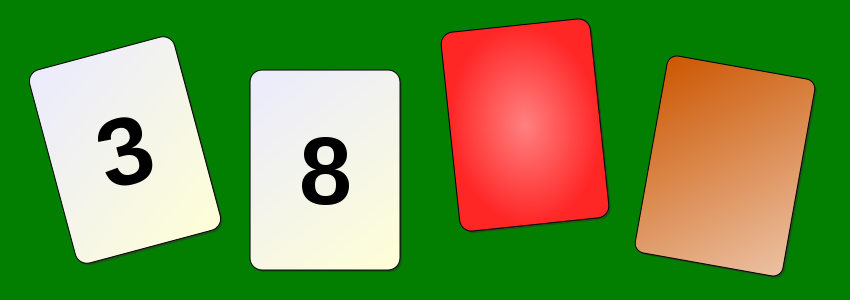
Original Question:
Each card has a number on one side, and a patch of color on the other. Which card(s) must be turned over to test the idea that if a card shows an even number on one face, then its opposite face is red?
Question in Bahasa Indonesia:
Gambar di atas adalah 4 kartu yang masing-masing memiliki sisi huruf dan sisi angka. Jadi, dibalik kartu “3” dan “8” tertulis suatu huruf dan dibalik kartu “Merah” dan “Coklat” tertulis suatu angka. Anda harus membuka 2 kartu untuk memeriksa kebenaran dari pernyataan, “Jika sebuah kartu menunjukkan nilai genap di satu sisi, maka sisi sebaliknya adalah warna merah.”. Kartu manakah yang harus Anda buka?
Note:
The Wason selection task (or four-card problem) is a logic puzzle devised by Peter Cathcart Wason in 1966. It is one of the most famous tasks in the study of deductive reasoning.
Untuk menjawab pertanyaan diatas akan lebih mudah jika kita memberikan konteks. Coba jawab pertanyaan di bawah ini:
Di sebuah bar terdapat 4 orang yang sedang minum.
Orang 1: Minum alkohol.
Orang 2: Minum non-alkohol.
Orang 3: Berumur 30 tahun.
Orang 4: Berumur 19 tahun.
Di dalam bar tersebut terdapat peraturan, “Semua yang minum alkohol harus berumur di atas 21 tahun.”.
Untuk memerika apakah aturan di atas ditaati, orang nomor berapa saja yang harus diperiksa? (Untuk Orang 1 dan Orang 2, kita harus memeriksa KTP-nya. Untuk Orang 3 dan Orang 4 kita periksa minumannya.)
The correct response is to turn over the 8 and the brown cards.
The rule was “If the card shows an even number on one face, then its opposite face is red.” Only a card with both an even number on one face and something other than red on the other face can invalidate this rule:
1. If the 3 card is red (or brown), that doesn’t violate the rule.
2. If the 8 card is brown, that violates the rule.
3. If the red card is odd (or even), that doesn’t violate the rule. Because it doesn’t necessarily mean that red card should only be facing an even number. Its only that an even number should be facing red but vice versa is not mandatory. As nothing is mentioned about odd numbers, even the odd numbers might be facing red. But its only that even numbers must be facing red.
4. If the brown card is even, that violates the rule.
Use of logic
The interpretation of “if” here is that of the material conditional in classical logic, so this problem can be solved by choosing the cards using modus ponens (all even cards must be checked to ensure they are red) and modus tollens (all non-red cards must be checked to ensure they are non-even).